|
| |
AAAA Attends Starry Nights Festival
October 16-18, 1998
Presented by the Town of Yucca Valley,
California
and the Western Region of the Astronomical League (WRAL).

Guest Speakers
|
|
NOTE: I was not able to attend all the presentations at the Starry Nights Festival.
This page summarizes the ones I did attend.
Refer to the Schedule of Events for a list of all Festival speakers.
Supernova Hunting
Wayne Johnson, OCA
|
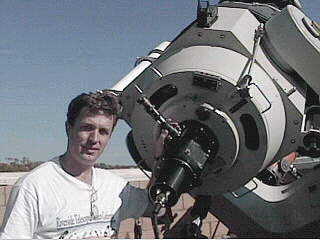 |
Wayne Johnson of the Orange County Astronomers spoke about his experiences as a supernova hunter. Wayne does all his hunting at the Anza Observatory
belonging to the OCA. The observatory building is an adobe brick structure, built by OCA club members “in the shadow
of Mt. Palomar.” Seeing can be quite good at the Anza observatory, especially when a “marine layer” of clouds covers
the cities along the coast. The 22-inch telescope mirror was ground by club members, and the CCD camera mounted
on the telescope is also home-built, with an imaging area of 1134x488 pixels.
Wayne is first and foremost a visual observer who is fond of looking at galaxies. Thus his nickname, Mr. Galaxy.
Even when he is doing astrophotography, Wayne says he looks at the objects he is going to photograph through the
telescope before taking the picture. In fact, the first supernova that Wayne discovered was found visually, although
all the others were found on CCD images he had taken.
Supernova hunting can be done both visually, and with small aperture telescopes. It is not necessary to have a
large telescope to find a supernova. Just persistence and good luck. Wayne says his search method could be classified
as “directed serendipity.”
If you happen to find a supernova, be sure to notify the International Astronomical Union (IAU), and be sure always
to verify any discovery you make before reporting it to the IAU. This usually means observations on two different
nights. Oftentimes, an observer can mistake another object in the field of view for a supernova, such as an asteroid
moving in front of a distant galaxy. For this reason, it is a good idea to verify with the Minor Planet Checker,
and the International Supernova Network on the Internet. Another source of information to verify a supernova discovery
is the STSCI Digitized Sky Survey.
If you are lucky, you will discover your supernova just as it explodes, or is brightening. However, most supernovae
are discovered past their peak, which means that not as much scientific information can be gleaned from the observations.
But reporting any suspected new supernova is important, because they are always of scientific interest. This is
partly because supernovae are standard candles and can be used as a distance indicator in distant galaxies.
To help in your search, a good detailed map of each galaxy you are observing is helpful. One good way to produce
a finder chart is to use a computer program. Wayne’s favorites are MegaStar and TheSky.
You can find out more about Wayne’s supernova hunting exploits at the Mr.
Galaxy Supernova Web Page.
AAVSO and Variable Stars
Gene Hanson, Tucson, AZ
|
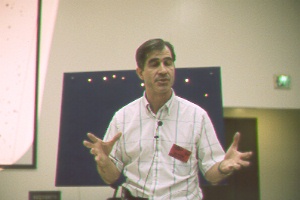 |
This was a very technical talk, and I only heard the end of it. The main points that I heard
Gene make are that SS Cygni is the most commonly observed variable star, and that the most accurate variable star
estimates are made within 2 magnitudes of the limiting magnitude of the scope you are using. This means that it
is better to use a small instrument for observing bright variable stars. Often, a binocular is just as good as
a scope.
Gene also made the point that, since observing logs usually scan a whole night past midnight, it is best to use
the ‘double date” notation on observing forms, for example, October 17-18, 1998, for the Saturday night of the
Festival.
“Objects You Can’t See”
Planets Around Other Stars
Leo Connolly
|
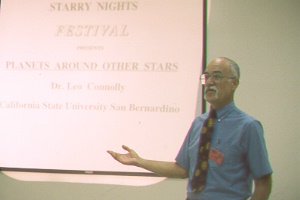 |
Dr. Leo Connolly is an astronomy instructor at San Bernardino State University.
On today’s list, there are 16 extra-solar planets that have been discovered. These planets are often considered
to be brown dwarfs, or “Jupiter Like” planets. In fact, the planetary systems so far discovered can be likened
to binary stars, with one of the components being a failed star. However, Jupiter itself is actually a planet rather
than a brown dwarf, since it is much too small to cause stellar ignition.
Most of the planets so far discovered are in this category, since the techniques of discovery tend to select for
larger planets. However, it is considered that since so many have been found in such a short time, that actual
planets similar to Earth are common in the galaxy. They are just too small for us to detect.
Methods of discovery fall into three categories: 1. Doppler Shift and Wobble, 2. Transit, and 3. Micro Lensing.
There is a great Web Page for those interested in extra-solar planets: http://cfa-www.harvard.edu/planets/ There is also a site sponsored by the Kepler Ames Research Center. http://www.kepler.arc.nasa.gov/
"More Things
in Heaven and Earth"
David Levy
|
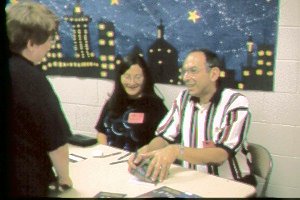 |
Amateur Astronomer David Levy is best known
as co-discoverer of Comet Shoemaker-Levy 9, which crashed into the planet Jupiter in 1994. However, David is not
only an avid amateur astronomer, but a student of English Literature and History. He has recently published a new
book which takes it’s title from a quote in Shakespeare, where Hamlet says to Horatio, “There are more things in
Heaven and Earth than are dreamed of in your philosophy .”
Although David is known as a comet hunter, he stressed that astronomy is not just the study of heavenly bodies,
but actually the “study of everything.” For the science of astronomy embraces physics, mathematics, chemistry,
and biology, just to name a few scientific disciplines.
Astronomy, he says, is not just for astronomers, just as poetry is not just for poets. It is for everyone. As amateurs,
we are as entitled to enjoy the beauty of the universe, as scientists are to describe it in scientific terms.
David’s talked covered a brief history of the scientists who made the first great astronomical discoveries, Tycho
Brahe, Copernicus, Galileo, Kepler, and Newton. The focus of this discussion was the impact their discoveries had
on the conventional wisdom of the day, and how it upset both rulers and religions leaders. He then mentioned great
poets who wrote about the spiritual and emotional impact of astronomy: Robert Frost, Henry David Thoreau, Fances
Bacon, Tenneyson, and Gerard Manley Hopkins.
As amateurs, moving through the beauties of the night sky, we come to an interest in astronomy from varied backgrounds.
And all of these viewpoints are equally valid in their own way. Just so the union of astronomy and poetry.
One of the most commonly recited verses in the English language is “Twinkle, Twinkle, Little Star.” But how many
of us know the complete poem written by Jane Taylor in 1806?
David finished by reminding us that, “Ideals are like stars. You cannot touch them with your hands. But if you
follow them, they will take you to your destination.” |
Twinkle, twinkle, little star,
How I wonder what you are!
Up above the world so high,
Like a diamond in the sky.
When the blazing sun is gone,
When he nothing shines upon,
Then you show your little light,
Twinkle, twinkle, all the night.
Then the Trav’ller in the dark,
Thanks you for your tiny spark,
He could not see which way to go,
If you did not twinkle so.
In the dark blue sky you keep,
And often thro’ my curtains peep,
For you never shut you eye,
Till the sun is in the sky.
‘Tis your bright and tiny spark,
Lights the trav’ller in the dark:
Tho’ I know not what you are,
Twinkle, twinkle, little star.
Jane Taylor, The Star, 1806
|
Pirating the Sun
Edwin C Krupp
|
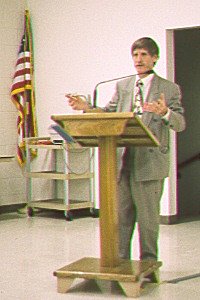
|
Dr. Edwin C. Krupp is the Director of Griffith Observatory in Los Angeles. He is also an
avid Eclipse Chaser. Last February, he led a trip sponsored by Griffith Observatory, to observe the eclipse at
sea, near the island of Aruba.
Dr. Krupp began by asking how many people in the audience had seen an eclipse. Since this was an astronomy convention,
most people raised their hands. He then asked of those people who had not observed an eclipse, if they had plans
to do so. Most answered negatively. He then asked those who had observed an eclipse, if they were planning to do
so again. All raised their hands. This story demonstrates the power an eclipse has on the human psyche. And it
indicates the commercial potential in selling eclipse trips.
Eclipses were once events that brought terror to the superstitious observers of an earlier age. But since 1842,
when the first scientific eclipse expedition was sponsored, taking scientists to Milan, Italy, eclipse trips have
become, by the late 20th century, as much an enterprise taken for entertainment as for scientific learning.
Dr., Krupp has been viewing eclipses since the 1960’s, when he passed up a trip to Mexico
to stay home and study for his graduate exam. He has seen nearly every eclipse since then, or at least been there
when it happened. Most recently, he lead the February 1998 expedition of the Cruise Ship Stella Solaris to Aruba
to view the Last American Eclipse of the Millennium. The Caribbean was once the play ground of pirates. Thus the
title, “Pirating the Sun.”
Dr. Krupp is an entertaining speaker, and filled his presentation with both visual and verbal jokes. He successfully
made his point that viewing eclipses as a recreational outlet is definitely a modern phenomenon.
Ed Flaspoehler
Vice-President, AAAA
Go to the AAAA Home Page
Go to the Starry Nights Menu
|



